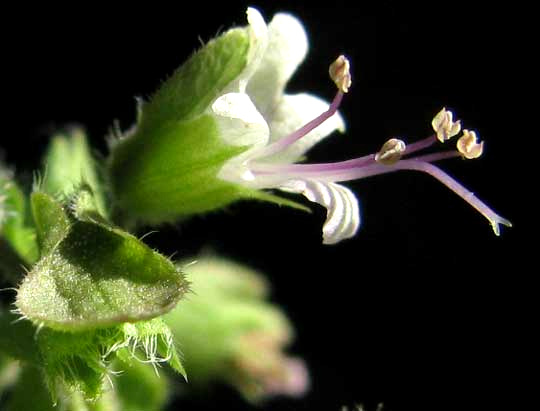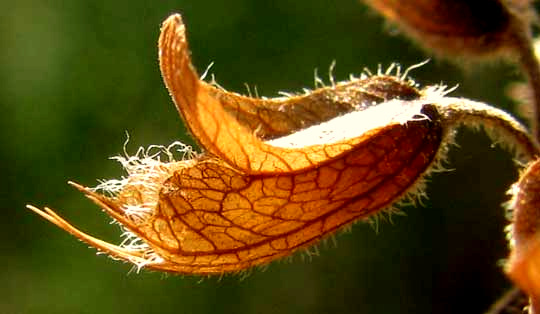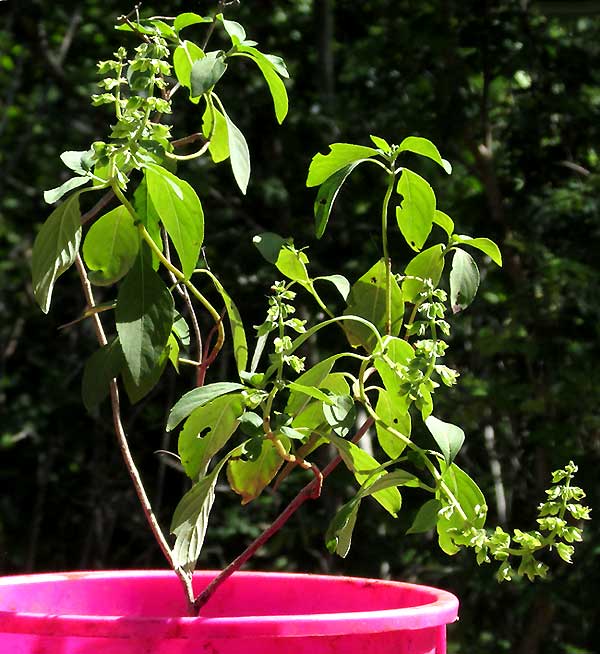Excerpts from Jim Conrad's
Naturalist Newsletter

from the March 13, 2011 Newsletter issued from Hacienda Chichen Resort beside Chichén Itzá Ruins, central Yucatán, MÉXICO; limestone bedrock, elevation ~39m (~128ft), ~N20.676°, ~W88.569°
WILD BASIL
About a month ago I was deep in the forest when along a shadowy trail I noticed what appeared to be a two-ft-tall (60cm) member of the Mint Family -- a darkish herb with two leaves arising at each node (opposite leaves) and with square stems. Pinching a leaf to see if it smelled, I wasn't prepared for the intensity of the minty fragrance that exploded around me. The odor was like very strong, sweetish anis. The plant wasn't flowering yet, however, so I couldn't identify it. Now it's flowering, as you can see above
Actually, those items looking like green flowers are nothing but calyxes, the white corollas having not emerged yet, or already fallen off. A close-up of some of the curiously "hooded" calyxes is shown below:

It's strange about the corollas -- that on the hundreds of plants examined, only rarely were corollas seen emerging from their calyxes, though they did litter the ground below the plants. If a corolla was in place when the plant was slightly jolted, the corolla fell off. I've seldom seen such loosely attached corollas. I did find one still in place, though, its four violet-filamented stamens tipped with tan anthers, and a violet, fork-tipped style, as seen below:

That picture also shows better the remarkable "cap" atop a calyx in its lower, left corner.
Locally this plant is well known by the Maya, who mostly use the Spanish name for it, Albahaca de Monte, which means "Forest Basil." English speakers are bound to call it "Wild Basil." It's OCIMUM CAMPECHIANUM, which means that it belongs to the same genus as Garden Basil, Ocimum basilicum, so our forest species is real basil and a real Mint Family member. Now that I think about it, its odor really is like very strong basil, with an herby undertaste.
Having the name, I could look up the plant on the Internet. I found pictures of the plant bristling with well formed corollas, so my observations about loosely attached corollas are even more curious. The literature reports that the species' preferred habitat is open, rocky, gravelly or sandy soil where sometimes it grows weedily. Our plants are in shady forest soil, so maybe their corollas fall easily because of suboptimum environmental conditions.
All the Wild Basil I've seen grows along forest trails so one day when some local Maya beekeepers parked their car at my hut before heading into deep forest I asked them outright if they'd sowed Albahaca del Monte along their trails. The head guy looked sheepish, as if he'd been discovered doing something bad, and admitted that he had, because bees love that plant, and if you sow it once it just keeps spreading itself year after year. What a pretty moment! I laughed so hard that immediately he knew I'd have done the same thing.
Ocimum campechianum occurs fairly regularly throughout most of the American Tropics, including southern Florida, where it is regarded as endangered.
Standley writes that in Belize a tincture of the plant's leaves in rum is used as a lotion to relieve rheumatism.
from the April 10, 2011 Newsletter issued from Hacienda Chichen Resort beside Chichén Itzá Ruins, central Yucatán, MÉXICO; limestone bedrock, elevation ~39m (~128ft), ~N20.676°, ~W88.569°
WILD BASIL'S CURIOUS CALYX UNDERSTOOD
Last month we commented on Wild Basil's strange calyx, with its upward flaring "hood" and its lower calyx teeth's long, slender points. Now the plants have gone to seed and you can see a dried-up calyx below:

Now I think I can interpret what's going on with that calyx. In the calyx's depths, the four-parted ovary produces four little black, seedlike "nutlets." I'm guessing that the hood atop the down-tilted calyx catches breezes, shakes the calyx, and helps the nutlets dislodge and slip to their position at the calyx's lower lip where the spines begin pointing upward. Not only that, I suspect that sometimes puffs of wind hit against the hood knocking the whole calyx upwards and backwards. This causes the nutlets to jump forward where the spines below them effectively lengthen the "arm" that's throwing the nutlets out of the calyx. The extra length provided by the spines produces greater tossing power, and the nutlets are dispersed farther from the mother plant, which is desired.
Therefore: In Nature when you see something that's weird, just study it long enough and eventually you understand what's elegant and beautiful about it.
issued on July 6, 2019 from near the forest just west of Tepakán; elev. ~9m (~30 ft), N21.053°, W89.052°; north-central Yucatán state, MÉXICO
WILD BASIL'S MEDICINAL & INSECTICIDE USES
While clearing a trail through the woods I came upon some Wild Basil, dug it up, planted it in a pot, and that's it below:

From what I've seen among the local Maya, if the family grows a few herbs around the house -- and many do -- the three most commonly planted species are Rue, White Sage and Basil. Different cultivars of Basil are grown, mostly of the garden Basil kind. Interestingly, all three of these are not native to the Yucatan. Rue and garden Basil are Old World, and White Sage is from the cooler Mexican uplands and North America.
Still, the medicinal use of our native Wild Basil is well documented, as in Carlos Amílcar's 2015 work Ocimum campechianum (Lamiaceae): su uso en la medicina tradicional, where it's reported that in various cultures infusions of our plant's leaves are used to treat colds, fever, upset stomach, dysentery, arthritis, paralysis, epilepsy and mental disorders. Sometimes crushed leaves are placed in bathwater to treat skin problems, and leaves are mashed to deal with a kind of parasite in nasal cavities.
Also Wild Basil can be used as an insecticide and as anti-microbial, and to control nematodes, and fungal infections. A 2019 paper by Laura Scalvenzi and others found that Wild Basil's essential oils killed larvae of the main mosquito spreading Yellow Fever, Dengue, Chikungunya and Zika viruses, Aedes aegypti. That paper is freely available online.
As certain insecticides are being removed from the market because of their negative effect on human health and the environment, and because many disease-spreading insects are evolving resistance to insecticides, more attention is being given these traditional, natural cures. And if I'm lucky enough to eventually grow a lot of Wild Basil plants from the seeds of the plant in my red plastic pot, maybe I'll become the Yucatan's Johnny Appleseed of native Wild Basil.